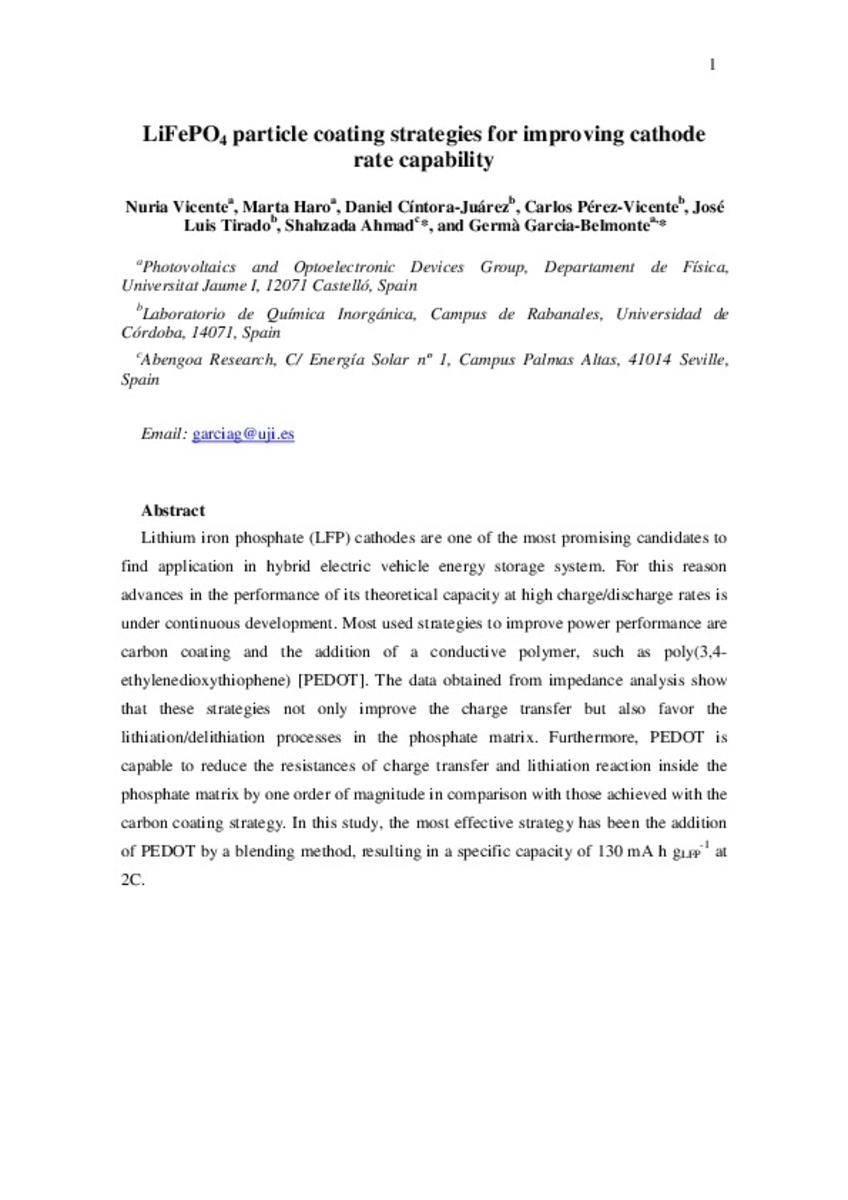Mostrar el registro sencillo del ítem
LiFePO4 particle conductive composite strategies for improving cathode rate capability
| dc.contributor.author | Vicente-Agut, Nuria | |
| dc.contributor.author | Haro, Marta | |
| dc.contributor.author | Cíntora Juárez, Daniel | |
| dc.contributor.author | Pérez Vicente, Carlos | |
| dc.contributor.author | Tirado, José Luis | |
| dc.contributor.author | Ahmad, Shahzada | |
| dc.contributor.author | Garcia-Belmonte, Germà | |
| dc.date.accessioned | 2016-05-16T14:06:25Z | |
| dc.date.available | 2016-05-16T14:06:25Z | |
| dc.date.issued | 2015-05 | |
| dc.identifier.issn | 0013-4686 | |
| dc.identifier.uri | http://hdl.handle.net/10234/159646 | |
| dc.description.abstract | Lithium iron phosphate (LFP) cathodes are one of the most promising candidates to find application in hybrid electric vehicle energy storage system. For this reason advances in the performance of its theoretical capacity at high charge/discharge rates is under continuous development. Most used strategies to improve power performance are the addition to the LFP particles of an electric conductive carbon or polymer, such as poly(3,4-ethylenedioxythiophene) [PEDOT] doped with polystyrene sulfonate (PSS). The data obtained from impedance analysis provide new insight on the role of these additives that not only improve the charge transfer but also favor the lithiation/delithiation processes in the phosphate matrix. Furthermore, PEDOT is capable to reduce the resistances of charge transfer and lithiation reaction inside the phosphate matrix by one order of magnitude in comparison with those achieved with the carbon coating strategy. In this study, the most effective approach has been the addition of PEDOT by a blending method, resulting in a specific capacity of 130 mA h gLFP−1 at 2 C. | ca_CA |
| dc.description.sponsorShip | We thank financial support from Generalitat Valenciana (Spain) under project num. ISIC/2012/008 (Institute of Nanotechnologies for Clean Energies), and MEC (Spain) under project num. MAT2011-22753. | ca_CA |
| dc.format.extent | 7 p. | ca_CA |
| dc.format.mimetype | application/pdf | ca_CA |
| dc.language.iso | eng | ca_CA |
| dc.publisher | Elsevier | ca_CA |
| dc.relation.isPartOf | Electrochimica Acta, 2015, vol. 163 | ca_CA |
| dc.rights | Copyright © 2015 Elsevier Ltd. All rights reserved. | ca_CA |
| dc.rights.uri | http://rightsstatements.org/vocab/InC/1.0/ | * |
| dc.subject | LiFePO4 composite | ca_CA |
| dc.subject | Impedance spectroscopy | ca_CA |
| dc.subject | Conductive polymer | ca_CA |
| dc.title | LiFePO4 particle conductive composite strategies for improving cathode rate capability | ca_CA |
| dc.type | info:eu-repo/semantics/article | ca_CA |
| dc.identifier.doi | http://dx.doi.org/10.1016/j.electacta.2015.02.148 | |
| dc.rights.accessRights | info:eu-repo/semantics/openAccess | ca_CA |
| dc.relation.publisherVersion | http://www.sciencedirect.com/science/article/pii/S0013468615004454 | ca_CA |
| dc.type.version | info:eu-repo/semantics/acceptedVersion |
Ficheros en el ítem
Este ítem aparece en la(s) siguiente(s) colección(ones)
-
INAM_Articles [503]
-
FCA_Articles [501]
Articles de publicacions periódiques







